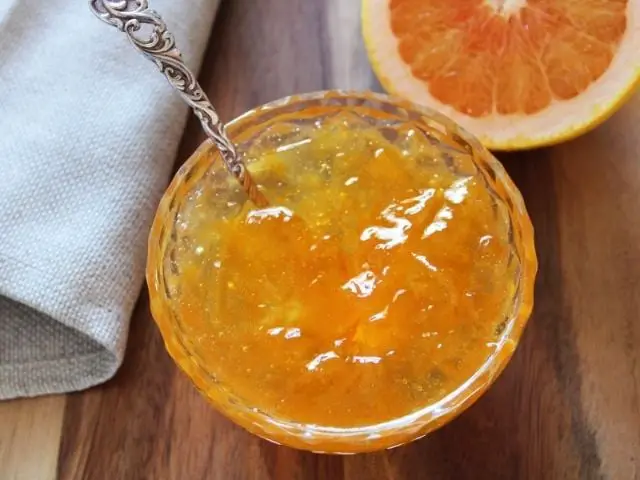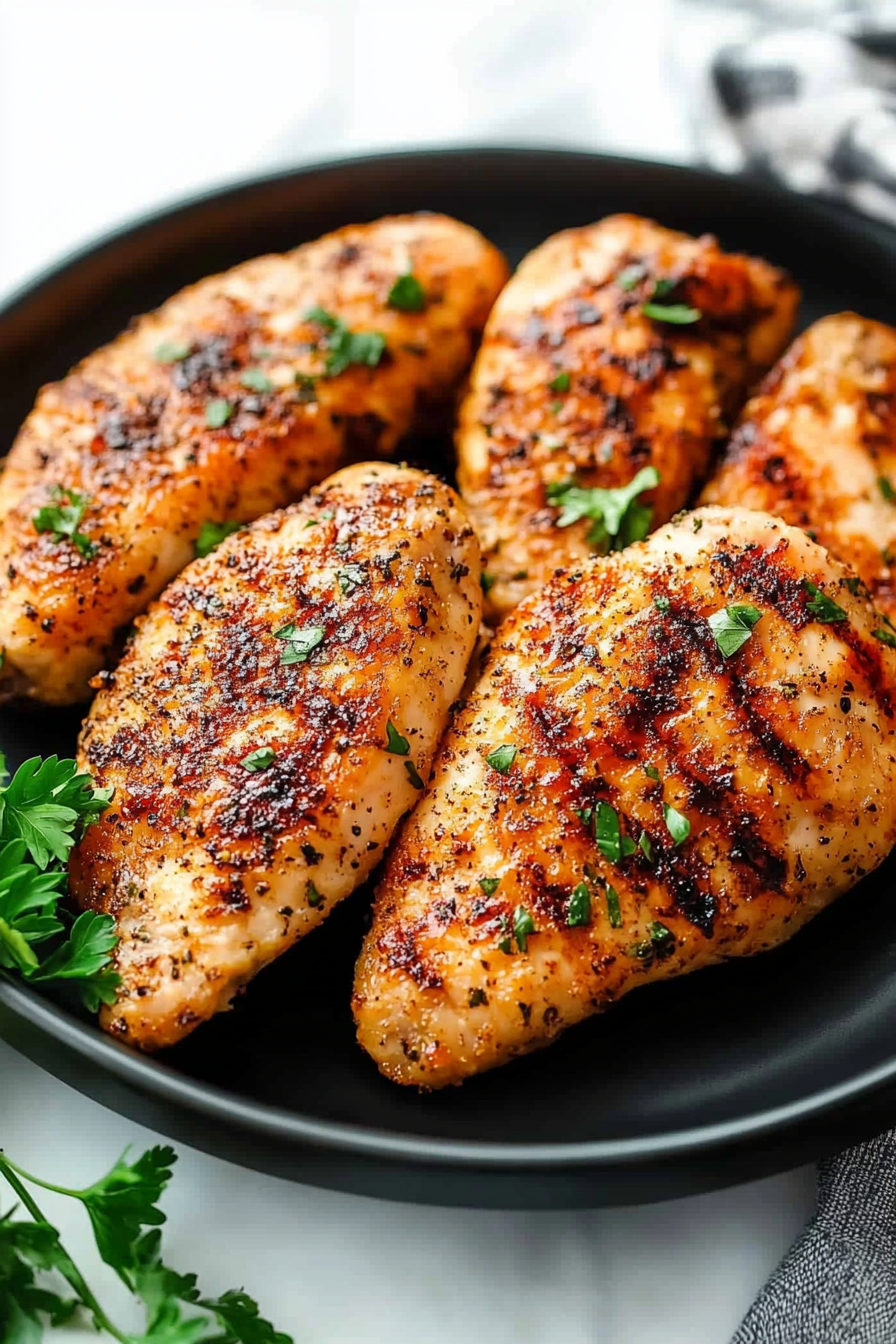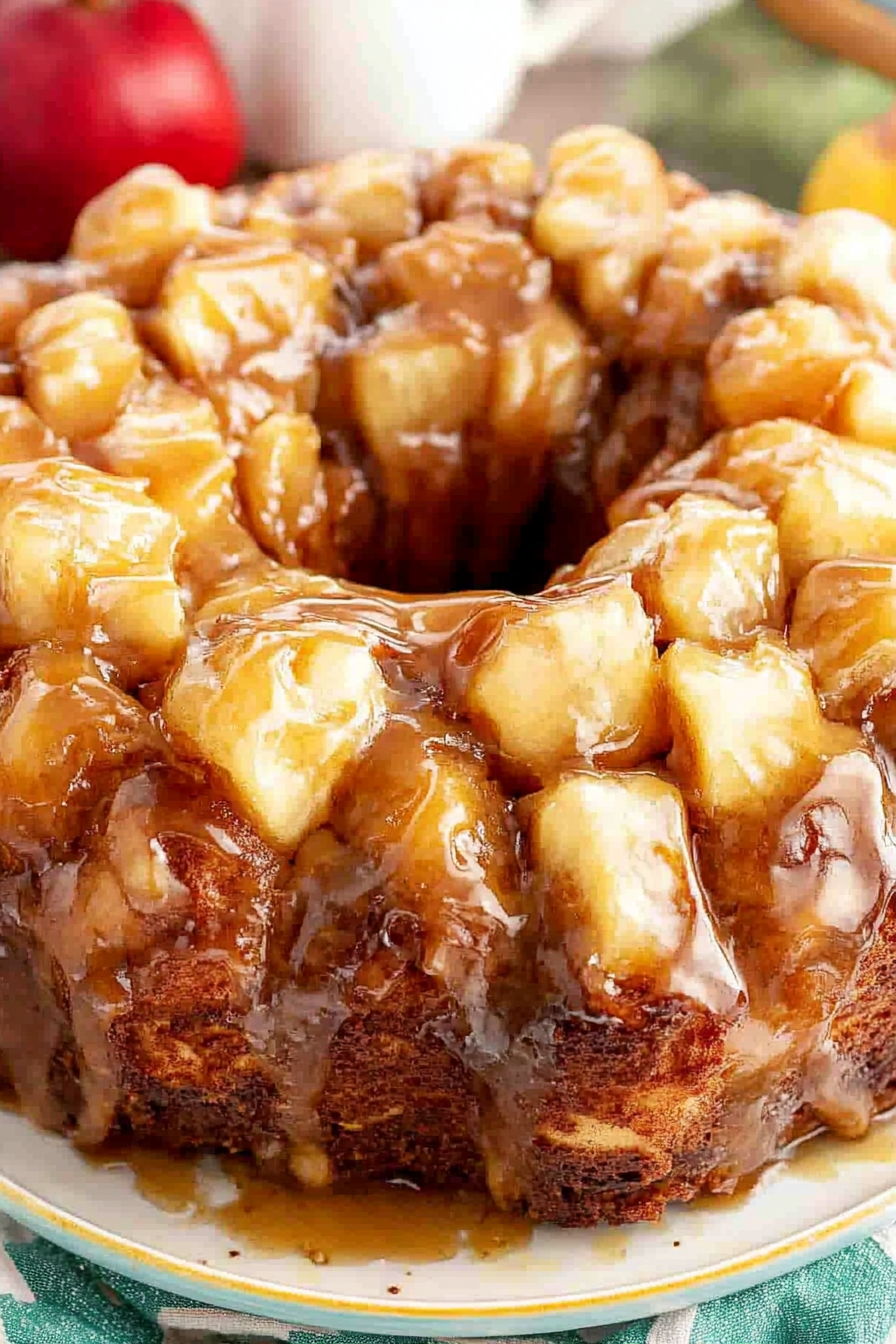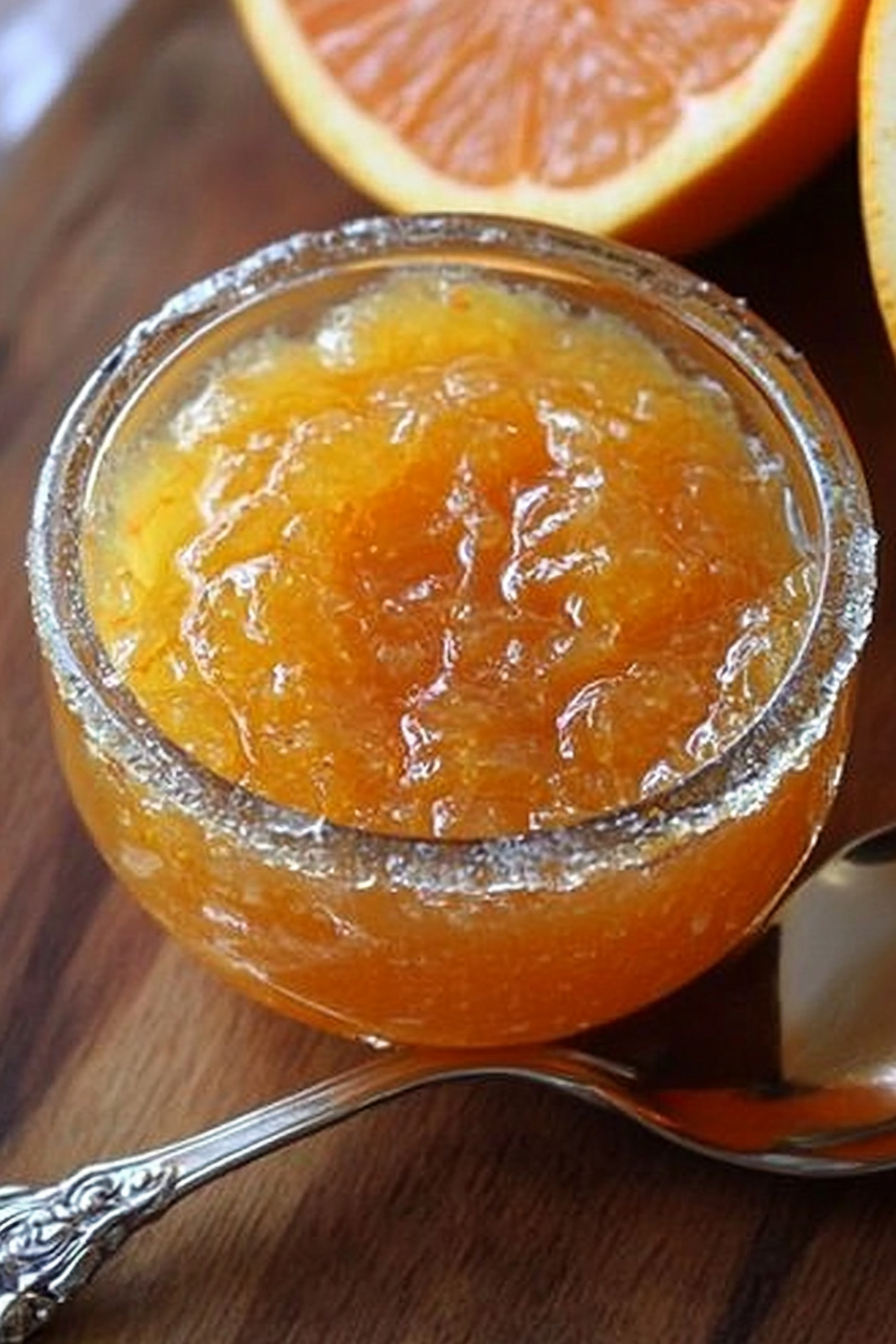The moment I first spooned grapefruit marmalade into a warm loaf batter, I felt like I’d bottled sunshine. It was a lazy Saturday morning, the kitchen smelled bright and tart, and my grandmother’s old radio hummed in the background with a jazzy tune that somehow matched the citrus glow in the air. Grapefruit Marmalade is more than a spread here; it’s a mood lifter, a little burst of spring during a long winter, and a reminder that dessert doesn’t have to mean heavy chocolate and hours in the kitchen. This recipe is a forgiving friend—easy enough for weeknights, special enough for weekend brunch, and always a crowd-pleaser. If you’ve compared it to lemon drizzle loaf in the past, think of this as the sunnier, more complex cousin: same quick batter, but the marmalade swirls give it a zing that makes you exhale with joy. I’ve made this countless times and it never fails to make the kitchen feel like a celebration, even when the toast rack is empty and the coffee is your only company.
What is grapefruit marmalade?
Think of Grapefruit Marmalade as sunshine preserved with a bit of rind-friendly bite. It’s essentially citrus pulp and juice gently cooked with sugar until it’s thick enough to hold a ribbon in the spoon. The name comes from the way the grapefruit’s bitter-sweet balance plays with the sugar, giving you a glossy, amber spread that tastes both tart and comforting. In this recipe, we’re not just spreading marmalade—we’re swirling it into a buttery, moist cake batter to create ribbons of tart sweetness that echo the bright, pale-green zest you can smell in the air when you first slice into the loaf. It’s a straightforward concept: a classic pound cake batter, a generous swirl of grapefruit marmalade, and a glossy glaze that ties the citrus and the cake together. It’s approachable, it’s pretty, and it’s surprisingly versatile.
Why you’ll love this recipe?
What I love most about this Grapefruit Marmalade cake is how it feels in the mouth: soft, moist, and gently citrusy, with little tart pockets that pop in every bite. The marmalade swirl isn’t shy—it’s bold enough to wake up your palate without shouting. This loaf is a lifesaver on busy nights when you want something homey with minimal effort. The process is simple: mix a handful of pantry staples, swirl in the marmalade, bake, glaze, and slice. It’s cost-effective, too—most of the ingredients live in our kitchens already, and the marmalade can be a jar you’ve had for ages, waiting for its moment to shine. My kids actually ask for seconds, and that’s saying something in our house where breakfast is a stern critic. The aroma alone—orange and grapefruit mixed with vanilla and toasty sugar—fills the room and makes the whole family gather in the doorway with cups of coffee. It pairs beautifully with yogurt or a light cheese board, but it also stands proudly on its own, sliced thick and shared warm with a pat of butter melting into the warm crumb. This recipe is forgiving, adaptable, and more than a little nostalgic—the kind of thing you return to when you need that cozy sugar-kick without feeling heavy.
How do I make grapefruit marmalade?
Quick Overview
Here’s the quick version: whip up a simple butter cake batter, swirl in a generous ribbon of grapefruit marmalade, bake until a tester comes out clean, then slather with a bright citrus glaze. The magic is in the swirl—don’t worry if it isn’t perfectly even; the marbling looks lovely in the loaf, and the marmalade will surrender its perfume to the crumb as it bakes. This method keeps things straightforward: you won’t be scrambling for a dozen bowls or chasing overmixed batter. It’s the kind of recipe that makes you feel like you’ve known it forever, even if you’re whisking your first batch today.
Ingredients
For the Main Batter:
- 1¾ cups (220 g) all-purpose flour, all-purpose or a 1:1 blend if you like
- 1 cup (200 g) granulated sugar
- ½ cup (115 g) unsalted butter, softened
- 2 large eggs
- ½ cup (120 g) plain yogurt or sour cream (for extra tenderness)
- 1 tsp baking powder
- ½ tsp baking soda
- ¼ tsp salt
- 1 tsp vanilla extract
For the Filling:
- ¾ cup Grapefruit Marmalade (about 180 g), warmed to loosen the spread so it swirls smoothly
- 2–3 tsp fresh juice (orange or grapefruit) to brighten if you like
- Optional: a pinch of orange zest for extra zing
For the Glaze:
- 1 cup powdered sugar
- 2–3 tbsp grapefruit juice (adjust for desired consistency)
- Optional: zest of ¼ grapefruit for color and aroma
Step-by-Step Instructions
Step 1: Preheat & Prep Pan
Heat the oven to 350°F (175°C). Grease a 9×5-inch loaf pan with butter or nonstick spray, then line the bottom with parchment if you’ve got it. A quick spray after parchment ensures the bread clings to the sides when you lift it out. If you’ve got a mini-loaf pan, you can make two smaller loaves for gifts—just adjust the bake time to 25–30 minutes.
Step 2: Mix Dry Ingredients
In a medium bowl, whisk together the flour, baking powder, baking soda, and salt. The goal is to distribute the leaveners evenly so every slice gets a gentle lift. I always whisk for about 15 seconds and then sift once if I have a sifter handy; it makes the crumb extra tender.
Step 3: Mix Wet Ingredients
In a separate large bowl, beat the butter and sugar together until pale and fluffy—this usually takes 2–3 minutes with a hand mixer or about a minute with a stand mixer. Add the eggs one at a time, beating well after each. Stir in the yogurt and vanilla until the mixture looks silky and not curdled.
Step 4: Combine
Fold the dry ingredients into the wet mixture in three additions, mixing just until you don’t see streaks of flour. Overmixing here makes a tough crumb, so stop as soon as the batter comes together. A thick, velvety batter is what you want—no more, no less.
Step 5: Prepare Filling
Warm the Grapefruit Marmalade in the microwave or in a small pot until it’s liquid enough to swirl. If it’s very thick, add a splash of juice to loosen. Taste and decide if you’d like a touch more brightness with a squeeze of fresh citrus. I sometimes stir in a teaspoon of orange zest for a punchy, sunny edge.
Step 6: Layer & Swirl
Spoon about half the batter into the prepared pan, then dollop the marmalade over the batter in ribbons. Use a butter knife or skewer to swirl gently—don’t overdo it. The idea is pretty marbling, not a syrupy mess. Add the remaining batter and swirl again with light strokes so the marmalade peeks through in ribbons rather than a solid layer.
Step 7: Bake
Bake for 50–60 minutes, or until a toothpick inserted into the center comes out clean with a few moist crumbs. Ovens vary, so if your loaf starts to color too quickly on top but isn’t baked through, cover loosely with foil and continue baking. A light golden crust is exactly what you want—the inside should stay moist and tender.
Step 8: Cool & Glaze
Let the loaf cool in the pan for about 15 minutes, then transfer to a rack to cool completely. A warm loaf will absorb glaze better, but this glaze hardens nicely as it sets. Whisk the glaze ingredients until smooth, then drizzle over the loaf in thick ribbons. If you want a brighter finish, add a little more grapefruit juice or a dash of lemon zest to the glaze.
Step 9: Slice & Serve
Once cooled, slice with a sharp serrated knife. The cake looks lovely when you cut it after about 20 minutes to rest, so you don’t smear the glaze. Serve with a dollop of yogurt or a smear of butter for a breakfast-style treat, or alongside espresso and fresh berries for a confident afternoon bite. The slices release a fragrant citrus perfume with every cut, and it’s hard not to smile when you see those pretty marmalade swirls peeking through.
What to Serve It With
This grapefruit loaf plays nicely across occasions, and I’ve found a few go-to pairings that feel like a little kitchen celebration every time.
For Breakfast: A simple bowl of yogurt, a handful of toasted almonds, and a hot cup of coffee. The tart-sweet balance wakes up the senses. If you’re in a rush, a slice on its own with a pat of butter is still magical.
For Brunch: Serve with a cheese board featuring mild brie or a ricotta spread, plus a light fruit salad. A glass of sparkling water with a splash of juice echoes the citrus brightness without weighing things down.
As Dessert: A scoop of vanilla ice cream or a dollop of crème fraîche on the side makes it feel extra decadent. A drizzle of extra marmalade on top can turn a humble slice into a showpiece.
For Cozy Snacks: Toasted slices, brushed with a touch more marmalade, and warmed under a broiler make a cozy midnight snack—perfect for long nights when you want something comforting without turning the oven back on.
Over the years, this loaf has become a family favorite that signals “relax, we’ve got this” after busy days. It’s one of those recipes that suggests a quiet moment of sharing—the kind where you pass the loaf to someone else with a grin and say, “Your turn to pick the next citrus notes.” If you’re baking for friends, cut into small squares or thick slices and arrange them on a pretty platter with a side of fresh fruit. It’s simple, but the effect is warm and homemade in the best way possible.
Top Tips for Perfecting Your Grapefruit Marmalade
These tips come from years of tweaking this loaf on busy weeknights and lazy Sundays alike. I’ve learned to trust texture, scent, and timing, and I bet you’ll pick up a few tricks too.
Grapefruit Prep: Zest first, then juice. Zest provides bright essential oils that flavor the batter when you whisk. Make sure to zest only the colored part of the rind; the white pith underneath is bitter and can throw off the balance. If you don’t want chunks in the swirl, whisk the marmalade briefly to break up the fruit pieces before you swirl.
Mixing Advice: Stop as soon as the batter comes together. Overmixing creates a tougher crumb, especially when you’re using a standard loaf pan. If you’re tempted to “just mix a little longer,” resist—fold gently and move on.
Swirl Customization: For a more dramatic swirl, layer batter and marmalade in thirds rather than in two layers. Or try a marbling technique by dragging a skewer through the batter in a figure-eight pattern to create more intricate ribbons.
Ingredient Swaps: You can swap yogurt for sour cream or buttermilk for a lighter crumb. For a dairy-free version, use coconut yogurt with a splash of almond milk and ¼ teaspoon of almond extract to compensate for richness. I’ve also done a half-and-half mix with applesauce to shave a little fat while keeping moisture steady.
Baking Tips: If your oven runs hot, lower the temperature to 325–350°F (165–175°C) and extend the bake time slightly. Place the loaf on the center rack and rotate halfway through to ensure even browning. Use a thermometer if you’re unsure—the internal temp should hover around 205°F (96°C) for a moist crumb.
Glaze Variations: Add a splash of vanilla or almond extract to the glaze for a different aroma profile. If you want a glaze that hardens like a candy coat, reduce the liquid and add a pinch of cream of tartar to stabilize the sugar. For a lighter glaze, mix in a little lemon juice to brighten without making it too tart.
This loaf has a way of teaching you patience: wait for the glaze to set, then cut—the slices hold their shape and showcase the marmalade ribbons beautifully. I’ve learned that a little restraint in the glaze yields a cleaner, more polished presentation, which matters if you’re sharing it as a weekend gift or posting a photo for friends online. The best lesson I’ve learned is to trust the simple combination of fruit, sugar, butter, and patience. It’s not fussy, but it’s deeply satisfying on every bite.
Storing and Reheating Tips
Storing this Grapefruit Marmalade loaf is easy, and it stays tender for days—if you keep it properly wrapped.
Room Temperature: Keep the loaf well-wrapped or in an airtight container for up to 2 days. The glaze helps seal in moisture, but you’ll still want to shield it from direct sun and heat to preserve the glaze’s shine and the cake’s tenderness.
Refrigerator Storage: If you’re making it ahead, slice the loaf and store slices in a container with a paper towel between layers to absorb any moisture. It will stay fresh for 4–5 days in the fridge; bring slices to room temperature before serving for the best texture and aroma.
Freezer Instructions: Wrap the loaf tightly in plastic wrap and place in a freezer-safe bag for up to 2 months. Thaw overnight in the fridge and re-warm slices gently in a low oven if you want the glaze to recrystallize with a fresh gloss.
Glaze Timing Advice: If you plan to freeze the loaf, you can apply the glaze after defrosting for a crisp glaze finish, or freeze with glaze and re-glaze after thawing for maximum gloss and a bright citrus hit.
In our house, this loaf is a “make-ahead, share-with-neighbors” staple—it’s easy to slice and package into little boxes for a thoughtful gift. And when you come home exhausted after a long day, that warm scent that greets you at the door? It’s basically a hug in loaf form.
Frequently Asked Questions
Final Thoughts
If you’re scrolling through a dozen weekend bake ideas looking for something that feels both comforting and bright, give this Grapefruit Marmalade loaf a try. It’s the kind of recipe you memorize after your first bake—easy to scale, forgiving if you overmix by a smidge, and still fancy enough to share with friends on a rainy Sunday. The marmalade creates a signature citrus perfume that lingers on your palate and in your kitchen long after the last crumb disappears. It’s also a recipe you can customize: swap in lime marmalade for a different vibe, add a handful of poppy seeds for texture, or pair it with a savory cheese plate to surprise guests. I’d love to hear how you make it your own—tell me in the comments any tweaks you’ve discovered, like a dash of cardamom or a swap for non-dairy yogurt you adore. Happy baking, friends, and may your slice be the sunshine you crave on a cloudy day. If you try it, please rate the recipe and share your variations—I can’t wait to hear what you do with your Grapefruit Marmalade loaf!

Grapefruit Marmalade
Ingredients
For the Marmalade
- 500 g grapefruit - prepared weight
- 1 large lemon
- 1.5 Liter water
- 1.8 kg sugar
Instructions
Please Read First
- Preserve making is quite simple, but we do recommend reading the recipe through first and following these tips: weigh your ingredients for accuracy. do not double the recipe or alter the quantities. yes, it’s a lot of sugar. It’s also a lot of water. When making marmalade, the sugar is not just a sweetener, it also assists with gelling and preservation. When prepared properly, your end result will be the perfect mix of sweet, citrus tang and bitter, as marmalade should be. This is an old-fashioned recipe. Use a very large saucepan as the marmalade needs to rapidly boil and will foam up and you don’t want it to overflow. Ensure the marmalade reaches setting point. Keep in mind the marmalade will be very liquid while hot. Do not over boil as you will risk burning the marmalade. Allow 24-48 hours once jarred for the pectin to activate and the marmalade to set properly. If after this time your marmalade hasn’t set, it likely wasn’t cooked for long enough initially. In this case, add the marmalade back to a clean saucepan with the juice of a fresh lemon. Bring back to the boil and start testing after 5 minutes of rapid boiling.
To Sterilise the Jars
- Sterilise the jars you'll be using to store the marmalade. Choose glass jars with an airtight, metal lid and ensure they have been washed in the dishwasher or by hand in hot soapy water then rinsed well. Check that the metal lids do not have rubber inserts. Preheat the oven to 130 Degrees C (270 F) and place the jars in the oven for 15-20 minutes.
For the Marmalade
- Place 2 saucers or small plates in the freezer, ready to check for the setting point of your marmalade. Thoroughly wash the grapefruit and lemon. Remove each end of the grapefruit to get rid of excess pith. Remove each end of the lemon. Cut the grapefruit and lemon into quarters length ways. Holding two of the quarters together, slice as thinly as possible and remove any seeds.
- Place the citrus slices in a non-reactive bowl. Add the 1.5 Liters of water, cover the bowl and leave the fruit to stand overnight, up to 24 hours. If your bowl is not large enough to accommodate all the water, add what you can and add the remainder the following day. The following day, place the fruit and water into a very large, non-reactive saucepan.
- Over medium-high heat, bring the fruit and water to the boil. Rapidly boil for approximately 15 minutes or until the peel is tender, stirring occasionally with a long-handled wooden spoon.
- Add the 1.8 kg of sugar and stir well to dissolve it. After dissolving the sugar, return the fruit to the boil, stirring occasionally. Continue to stir until the marmalade reaches setting point. When the very aggressive bubbles subside to a slower, gentler boil, that's an indication that your marmalade may have reached setting point. Remove from the heat to conduct the wrinkle test. If not set, continue to boil for another 1 minute and then test again.
- To test for setting point, use the “wrinkle” test. Take one of your saucers from the freezer and pour a small amount of marmalade onto it. Let it cool for a minute then push against the marmalade with the tip of your finger. If the surface wrinkles slightly, it means setting point has been reached. Alternatively, if you are not confident checking this way, use a jam/candy thermometer which you clip to the side of your saucepan. Your marmalade has reached setting point when the temperature reaches 104.5 degree C or 220 degrees F. At this time, your marmalade will look very liquidy - it can take 24-48 hours to completely cool and set. Please note, this recipe will produce marmalade which has a soft set; it will not be as firm as many commercial varieties which often contain additives.
- Take the mixture off the heat. If there is any scum on the marmalade, add a teaspoon of butter and stir; that should settle the scum.
- Let the marmalade stand for about 10 minutes to allow the fruit to settle. If you bottle it immediately, the fruit will not be evenly distributed but will settle at the top of the jar.
- Remove your jars from the oven and carefully ladle the marmalade into the heated, sterilised jars. The jars should be filled as full as possible to minimise the amount of air between the marmalade and the lid. The marmalade should not touch the lid. Seal tight once filled with marmalade. Be very careful. Splashing yourself with hot marmalade will result in a very serious burn.
Notes
Featured Comments
“Impressed! Clear steps and creamy results. Perfect for busy nights.”
“New favorite here — quick weeknight win. crowd-pleaser was spot on.”
“Super easy and turned out amazing! My family asked for seconds. Saving this one.”
“This sweet treat was absolutely loved — the zingy really stands out. Thanks!”
“Made it tonight and wow — absolutely loved! Will definitely make Grapefruit Marmalade again.”
“Packed with flavor and so simple. Exactly what I wanted from Grapefruit Marmalade.”












